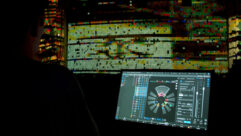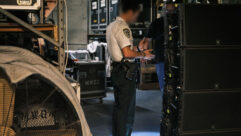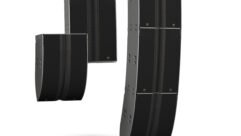
L-Acoustics 112XT
Mar 1, 2004 12:00 PM,
By John McJunkin
L-Acoustics 112XT
There are any number of brand names that are synonymous with the products that they represent — so much so that the brand becomes the generic term for the product (much to the chagrin of that company). When you say tissue, people often think of Kleenex. When you say photocopies, people frequently think of the name Xerox. And when you say line array, people think V-DOSC, the landmark product from L-Acoustics. V-DOSC is regarded by most as the standard in line array loudspeaker technology. This is top-shelf technology and is really not cost-effective for seminar, resort, or house-of-worship level usage. L-Acoustics does, however, make products intended for use by integrators at this lower cost level for applications such as distributed systems, theater surround, front-of-house (FOH) in smaller venues, or stage monitoring. I’ll examine the 112XT, which is a versatile loudspeaker that is useful in several ways.PHYSICAL ATTRIBUTESThe 112XT ($1,800), as the name implies, features a 12-inch low-frequency (LF) driver with a 3-inch voice coil and a 1.4-inch exit titanium-diaphragm compression driver for high frequencies (HF). The high frequency is directly loaded by the low frequency in a coaxial configuration. The enclosure is essentially a 21-by-16-by-15-inch floor wedge — shaped box with a slightly curved front face. The trap angle of the rear panel is 45 degrees with respect to vertical, facilitating use as a floor wedge. It’s made of Baltic birch plywood, features two Neutrik 4-pin Speakon connectors, and it also has integrated flying hardware, nicely placed handles, and a polemount socket for use with a subwoofer in a speaker-on-a-stick configuration.VITAL STATSThe published frequency response is 65 Hz to 18 kHz (±3 dB) with the Front preset (more on that in a moment), and L-Acoustics claims a usable bandwidth of 55 Hz to 18 kHz (-10dB). Power handling is 580W recommended, 1160W peak for the LF driver and 540W recommended, 540W peak for the HF driver, both at 8ž impedance. The published -6 dB nominal directivity of the package is 90 degrees (±20 degrees). Efficiency is rated at 98.5 dB sound pressure level (SPL) for the LF driver, and efficiency is higher for the HF driver at 106 dB SPL (both at 2.83 Vrms @ 1 meter). L-Acoustics publishes a broadband system output rating, as distinct from the efficiencies of the two separate drivers. In the front preset, the rating is 122 dB SPL continuous, 128 dB peak; in the fill preset, the rating is 124 dB SPL continuous, 130 dB peak; and in the three-way preset, the rating is 125 dB SPL continuous, 131 dB peak. The recommended crossover is a 24 dB/octave Linkwitz-Riley at 1 kHz.By now, you’ve probably formulated an idea as to what is meant by front, fill, and three-way presets, and you’re probably spot on. The Front preset provides 3 dB low-frequency and high-frequency contours under free field conditions, essentially for free-flown or speaker-on-a-stick configurations with no subwoofer. The Fill preset provides an essentially flat response under free field conditions, typically for use with a subwoofer in drum sidefill applications. The three-way preset applies a 100 Hz highpass filter, for use with a subwoofer for front of house. L-Acoustics makes these presets available on PC cards for use with popular drive racks from companies like XTA and BSS. Interestingly, L-Acoustics is secretive about the details of these presets, because a huge amount of engineering goes into the development of each one.COAXIAL LOADING FOR BIG ROOMSThe big advantage of coaxial loading is that the directivity of the output is symmetrical vertically, horizontally, and diagonally (or as L-Acoustics says, “axi-symmetrical”). The RT60 of an auditorium decreases smoothly above 1 kHz, and the energy dispersion of lower frequencies is relatively constant farther away in the venue because of reverb. An axi-symmetrical speaker such as the 112XT can thus be aimed at the back of the venue, and high frequencies are efficiently delivered there, with balanced SPL attenuation over the distance of the direct field. The ultimate result here, according to the 112XT manual, is that “at closer listening positions, the off-axis attenuation at higher frequencies provides a similar tonal balance, and the attenuation with distance is less.” The bottom line is that you get high frequency to the back of the room without ripping off the faces of the people in the front row with it. It’s a natural, smooth dispersion.FIRE ‘EM UP!I took the review unit, along with the provided L-Acoustics LA17a amplifier, to the Conservatory of Recording Arts and Sciences’ brand-new 5,000-plus square foot live sound venue in Gilbert, Arizona. With the assistance of Keith Morris, the Conservatory’s main live sound instructor, and a handful of instructors and students, we put the 112XT through its paces. Renowned live sound authority Robert Scovill is an acquaintance of mine, and had told me that when I put this small L-Acoustics speaker up that I would be “blown away” by the phase coherency, and he was right. The coaxial configuration indeed provides a tightly coherent image across the frequency range. We looked at phase with SIA-SMAART, and the congruence was spot-on. And in regard to L-Acoustics’ brilliant coaxial loading scheme, the results were obvious. The smooth energy dispersion enabling high frequency to get to the back of the room without killing the front of the room was probably the most striking characteristic that we noted. From a more subjective perspective, we fired up some popular listening material, including the likes of Steely Dan. The consensus was that this speaker sounds like a high-end near-field studio monitor, only capable of much higher sound pressure level.WE NOW CONCLUDE THIS TEST…Most smaller local contracting firms simply could never withstand the capital hit that would be necessary to get into L-Acoustics’ high-end, high-dollar systems. Luckily, the manufacturer presents a less expensive, albeit high-quality, alternative. These versatile speakers can be used for FOH in smaller venues with truly excellent results. They’re absolutely perfect for distributed systems and delay rings, particularly for classical applications, but also for discrete multichannel operation for theater surround. They will also not only please but astonish drummers in sidefill applications. Finally, they present a high-quality solution when used as a floor-wedge monitor. You’d be hard pressed to find a better wedge at any price. Although these speakers are priced for the prosumer market, they perform like something that costs significantly more.John McJunkinis the principal of Avalon Audio Services in Phoenix. For more than 20 years, he has engaged in studio recording, live sound, and broadcast, and he consults in design and commission for numerous studios and artists.SPECIFICATIONSFrequency Response 65 Hz-18 kHz (±3 dB) (Front preset); usable bandwidth 55 Hz-18 kHz (-10 dB)SensitivityLow Frequency (2.83 Vrms @ 1m) 98.5 dB SPL 65 Hz-1 kHzHigh Frequency (2.83 Vrms @ 1m) 106 dB SPL 1-18 kHzPower Rating (Long Term)LF: 48 Vrms; 290 Wrms; 1,160W peak; 580W; impedance 8žHF: 33 Vrms; 135 Wrms; 540W peak; 540W; impedance 8žNominal Directivity (-6 dB) Axi-symmetrical 90 degrees (± 20 degrees)System Output (one enclosure)Front Preset 122 dB SPL (continuous); 128 dB (peak); 3 dB low- and high-frequency contours under free field conditionsFill Preset 124 dB SPL (continuous); 130 dB (peak); nominally flat response under free field conditions3W Preset 125 dB SPL (continuous); 131 dB (peak); 100 Hz highpass filterComponents Low-frequency 1 × 12″ weather-resistant loudspeaker (3″ voice coil); high-frequency 1 × 1.4″ exit compression driver (titanium diaphragm, 3″ voice coil, coaxial assembly)EnclosureHeight 21.3″ (540 mm)Front Width 16.1″ (410 mm)Rear Width 6.5″ (165 mm)Depth 14.8″ (375 mm)Trap Angle 45 degrees with respect to verticalWeight 59.5 lb. (27 kg)Connectors (2) 4-pin Neutrik SpeakonMaterial 18 mm, 30 mm Baltic birch plywoodFinish Maroon-grayGrille Black epoxy perforated steel with acoustically transparent foamRigging Integrated flying hardware, handles and polemount socketAdditional Equipment OEM factory presets for approved digital processors; L-Acoustics SB115, SB118, SB218, dV-SUB subwoofers; L-Acoustics LA 17a or LA 24a power amplifierPRODUCT SUMMARYCompany: L-Acoustics US; www.l-acoustics-us.comProduct: 112XTApplications: Floor-wedge monitor, FOH loudspeaker for small venues.Price: $1,800










